Friday 14th June 2024

It’s some time off completion but my visit to Cardiff and the Valleys the weekend before last confirmed work is well in hand to transform the area’s rail network into a modern, electrified ‘turn-up-and-go’ Metro branded system.
A new fleet of trains manufactured by Stadler are destined for the network including 24 Class 756 tri-mode four car (17) and three car (seven) trains as well as 36 Class 398 three car tram-trains. In the longer term the plan is to run the latter on both the railway and on-street running including a new direct link from Cardiff Central to an expanded Cardiff Bay station in time for a proposed £250 million indoor arena due to open in 2026.
Obviously electrification of the lines is part of the project with the TAM lines (Treherbert, Aberdare and Merthyr Tydfil) already completed.
Which all sounds very ambitious and exciting so I thought I’d take a look at the ‘work in progress’ particularly as a major development towards the longer term objective began on 2nd June with improvements in frequencies and additional services on what are known as the ‘Core Valley Lines’ (CVL).
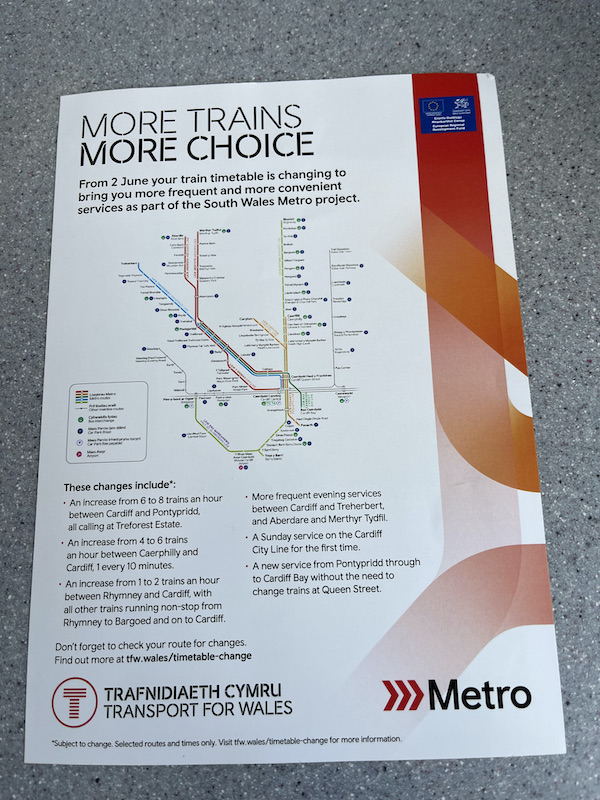
A promotional leaflet being handed out at Cardiff Queen Street station on Saturday confirmed an increase from six to eight trains per hour between Cardiff and Pontypridd (with the additional two originating from, or continuing to, Cardiff Bay), an increase from four to six trains an hour between Cardiff and Caerphilly and trains to Rhymney doubling from hourly to half hourly “with all other trains running non-stop from Rhymney to Bargoed and on to Cardiff” meaning alternate trains miss out the three stations between Rhmney and Bargoed.
There are also more frequent evening services between Cardiff and Treherbert, and Aberdare and Merthyr Tydfil and a Sunday service on the Cardiff City Line for the first time.
The new arrangement of two of the four shuttle trains an hour between Cardiff Bay and Cardiff Queen Street being extended to Pontypridd provides a new half-hourly through service without the need to change.

As well as the electrification infrastructure another visual clue that improvements are on the way can be found alongside Taff’s Well station (on the line to Aberdare/Merthyr Tydfil) where a huge new depot has been constructed with some of the fleet of the Stadler Class 398 tram-trains awaiting introduction into service standing in adjacent sidings.
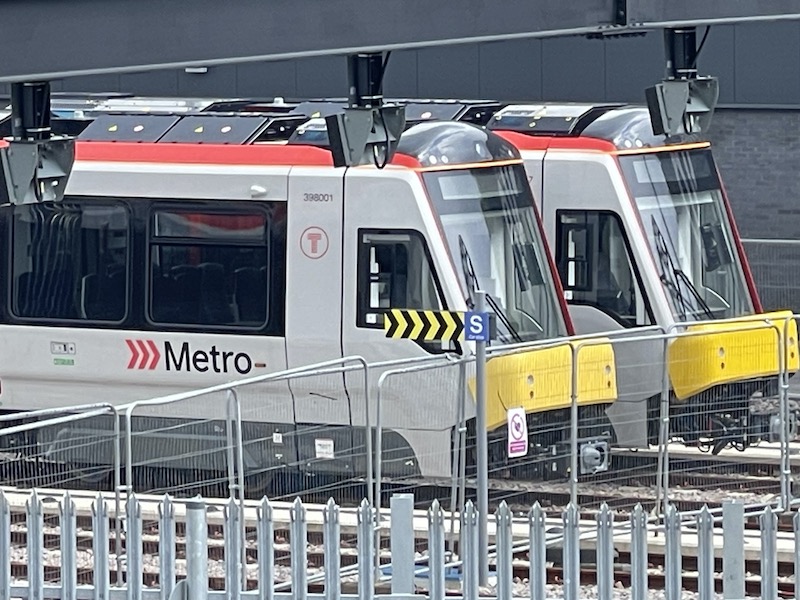
Access into the new depot has been built with a 180 degree curve from the tracks towards Cardiff as can be seen from the photograph below taken from the footbridge at Taff’s Well station.

Next to the new depot is a new Core Valley Lines Integrated Control Centre (CVLICC) which will control all the CVL except for when trains pass through Cardiff Central which will continue to come under the Wales Operating Centre (WROC). Some trains will start their route under CVLICC, pass through WROC and then return to CVLICC – the railway loves its acronyms.
The 105 mile CVL network can look forward to further frequency enhancements once the project comes to fruition as show below…

… which means Pontypridd will enjoy, on average, a train every five minutes to Cardiff (up from today’s eight trains an hour). The above map/diagram shows proposed train frequencies per hour.

Before all this can become a reality, major signalling and track upgrades are needed at Cardiff Queen Street to facilitate these improvements as well as a transformation of the branch down to Cardiff Bay, which can currently only be accessed from Cardiff Queen Street.
The regulatory status of the branch will be reclassified as ‘non-mainline’ so that it is operated with tramway lineside signalling, precluding heavy rail vehicles from using the route as well as a doubling of the existing single track. The plan is for tram-trains to operate through from Treherbert, Aberdare and Merthr Tydfil to Cardiff Bay which entails six tram-trains an hour crossing the path of the Rhymney and Coryton lines – as can be seen in the map diagram above – but the plan is not to completely electrify what will be a complex remodelled junction but instead the tram-trains will switch to battery operation for that section.
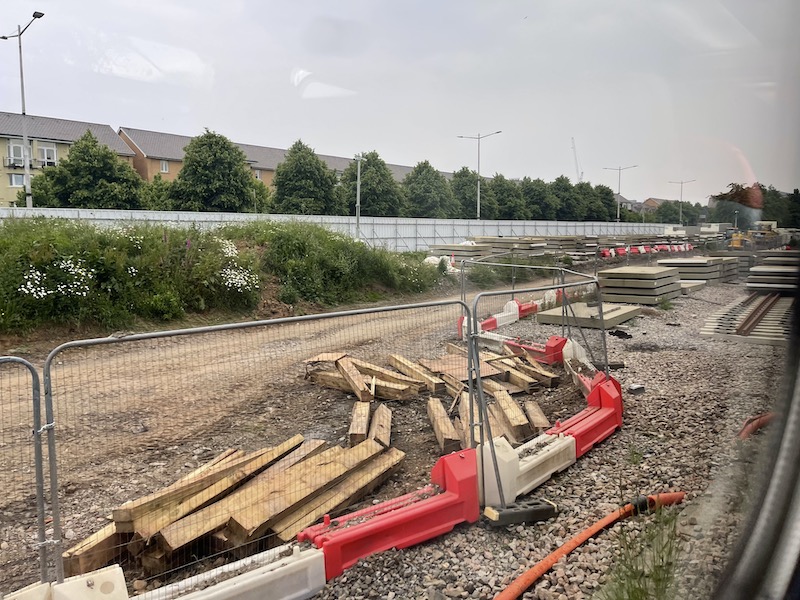
Work is also underway building a new station at Butetown, midway on the spur to Cardiff Bay as cab seen in the above photo…

… as well as an expanded terminus at Cardiff Bay where there’ll be a completely new much wider island platform as depicted in this artist’s impression…

…with tracks either side to cope with crowds attending events at the new Arena – see photo below.
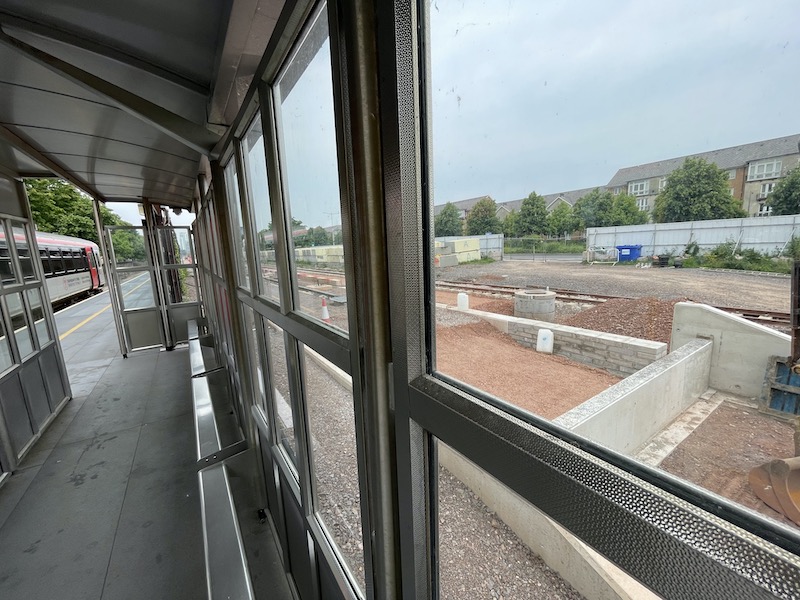
Although not shown in the astist’s impression, the existing bay platform will be retained and could be used at times of major demand. Cardiff Bay is set to receive three car tram-trains instead of, on occasions, a one car train and an increase to six (tram-) trains an hour the new ‘station’/tramstop at Butetown, making for quite an improvement.

When you travel up and down the Valley lines it soon comes across how inappropriate the old style noisy diesel trains are for the future vision of a turn-up-and-go frequent Metro network and the tram-trains will provide a much improved ambiance from the heavy rail vehicles currently in use on these lines.
Passive provision is being made for on-street extensions for tram-trains including at Butetown where a short on-street spur is proposed to Cardiff Central via Callaghan Square thus avoiding the need for passengers arriving at Cardiff Central on the main line having to make a convoluted change via Queen Street. There’ll also be passive provision for an on-street tram extension from Cardiff Bay further southwards.
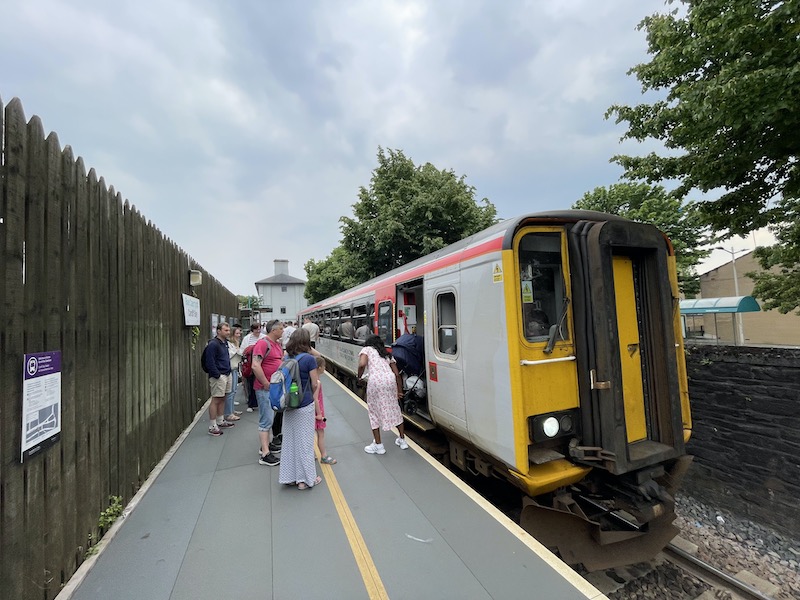
Inevitably the CVL Metro project is well behind its originally planned timescales but it will be transformational once finally complete and I look forward to a return visit.

While in Cardiff I also had a peep at an even more delayed project – the city’s new ‘bus station ‘Bus Interchange’ which thankfully is finally going to open at the end of this month.

It has 14 bays (compared to 34 in the old bus station which closed in 2015) and an entrance from the piazza outside Central Station (where the old bus station was located).
It’s unfortunate TrawsCymru routes T4 (Cardiff to Brecon and Newtown) and T14 (Cardiff to Hay-on-Wye and Hereford) won’t be using the Interchange nor National Express coach services.
Here are a few sneak preview photographs showing the passenger concourse and waiting area…

…where it looks like there are only ‘perch’ type seats…

… and the bus manoeuvring area…

… with the drive on and reverse off bays.

I look forward to another visit to Cardiff once it opens to have a look around. Here’s hoping it’ll be well worth the seven year wait.
Roger French
Temporary enhanced blogging timetable: 06:00 Daily.
Comments on today’s blog are welcome but please keep them relevant to the blog topic, avoid personal insults and add your name (or an identifier). Thank you.


Andrew Kleissner
Just to say that the service between Cardiff Queen Street and the Bay is actually now less frequent than of yore, as it was previously a regular shuttle every 12 minutes. Running trains to and from Pontypridd will certainly be more interesting for drivers!
The whole point of purchasing tram/trains was for use on the projected on-street extension to the Millennium Centre and Bute Dock. Much was made of this as the project was started, but it seems to have been quietly postponed.
Resignalling at Queen Street will be very helpful. I have been at Central on a busy Saturday, with eastbound trains piling up but frustrated by having to wait for signals along the chord to Queen Street to clear.
As for new trains: we had Pacers until a couple of years ago, then some Class 769 units – they were apparently unreliable and didn’t last long, but helped to fill a gap when TfW had an acute rolling stock shortage. Meanwhile the Class 150 Sprinters soldier on, sometimes very inappropriately on services to Fishguard and Holyhead.
LikeLike
It also looks like TfW have caved to the Unions and will be running the tram trains with more or less the same despatch approach as the rest of the network, thus losing all the benefits which could have obtained by switching to the much faster approach used on Tramlink for example.
LikeLike
Yes, they pledged that safety-critical guards’ duties would continue on the Class 398-operated lines, so the doubling of frequencies will result in a doubling of train crew costs.
I’d suggest that providing well-paid, highly-unionised public sector jobs is seen as important by the Welsh Labour Party.
Chris B
LikeLike
Every major city in Europe says one person operated trams are safe so I’m not why South Wales should be different. Do the locals struggle with getting on and off trams safely?
LikeLike
The problem with socialism is that eventually they run out of other people’s money.
LikeLiked by 1 person
If it was me I would offer to retrain the guards as the required additional drivers, (presumably drivers are paid more), to double the frequency. Future tram train expansion onto new routes, offers the prospect of even more jobs. As you introduce new build LRT routes the absurdity of guards dispatching from every stop increases. You could also recruit a revenue protection team from the guard pool.
Peter Brown
LikeLike
The idea that you need two crew to safely operate what is in essence a 40m two-section tram running on a reserved right of way is risible.
LikeLike
I do not think it is unfortunate that T4 or T14 or National Express will not be able to use the new Cardiff Interchange it is bad planning. They should have worked out the number of stands required and planned accordingly.
We have the same problem in Hereford where Herefordshire Council have just approved a £10million rail/bus interchange which will deliver 4 bus stands and a layby for pssing buses in place of the existing 12 stand bus station.
LikeLike
The selection of routes seems rather random. Usually one expects inter-urban rather than local routes to use the bus station if there isn’t the capacity for all.
According to Wales Online these are the ones which will be using Cardiff bus station:
124 to Maerdy (Stagecoach)
122 to Tonypandy (Stagecoach)
30 and X30 to Newport (Cardiff Bus / Newport Bus)
6 to Cardiff Bay (Cardiff Bus)
13 to Drope (Cardiff Bus)
136 to Pentyrch & Creigiau (Cardiff Bus)
21 and 23 to Rhiwbina, Whitchurch and Pantmawr (Cardiff Bus)
24 and 25 to Llandaff & Whitchurch (Cardiff Bus)
27, 28 and 29 to to Llanishen and Thornhill (Cardiff Bus)
35 to Gabalfa (Cardiff Bus)
61 to Pentrebane (Cardiff Bus)
62 and 63 to Rhydlafar, Radyr and Morganstown (Cardiff Bus)
92, 93 and 94 to Penarth and Barry (Cardiff Bus)
95 and 96 to Barry (Cardiff Bus)
305 to Dinas Powys (Cardiff Bus)
Chris B
LikeLike
A quart does not fit into a pint pot. Quite a lot of the bus service will not be using the bus station simply because it does not have the capacity
The old bus station operate at close to capacity so how they think one less then half the size is adequate is a bit of a mystery but it does seem to be common practice to build bus station that are to small
LikeLike
Andrew Kleissner
Saw this years ago at Hammersmith in London although there they were able to enlarge the station.
I wonder if the planners/architects think of bus station as bus stops, thinking that buses only pause for a few seconds rather than waiting for departure times or laying over?
Newport bus station seems to work well, although I’ve only walked past it rather than used it.
LikeLike
Newport has almost two bus stations, The original one when rebuilt was a bit to small so another smaller one was opened in Market Square which is just across the road. Since then as well here has been quite a decline in the number and frequency of the bus services in Newport so it has plenty of capacity
LikeLike
It is unbelievable that new bus stations are so much smaller. Sometime in the future many more journeys in Britain will have to be by bus or train instead of by private cars, so why not build the infrastructure now, as happens across the Channel?
Also how can anyone still order “perch-type ” seats? What century are we in? Do charities for the old not get a look-in in future designs?
malcolm chase, Buses Worldwide
LikeLiked by 1 person
I think the perch type seats are to prevent the homeless using them but I agree, it shows what our society has become when you need to do things like that.
LikeLike
When the old bus station closed a number of services didn’t stop from there anyway, they went from surrounding bus stops. I imagine they will probably do the same now. This is how I would do it:
52/57/58 – Wyndham Arcade.
1/2/7/8 – Canal Street
4/9 – Wood Street
44/45/49/50 – Wyndham Arcade
I do hope that they put the T4,T14, X3 and the X2 from there as they are long distance routes.
LikeLike
This assumes that’s there are no further to the stops and highway around the city centre once the new interchange is open.
LikeLike
The Metro project with tram trains looks transformational, but really needs to operate on line of site rather than railway signalled (on the sections exclusively for these services) to realise the full benefits.
Also more street running and/or new segregated routes needed to justify actually having tram style vehicles.
On that note any new lines should minimise sharp curves. Watching tram cab ride videos on YouTube it is apparent that UK systems are poorly built with ridiculous 10 and even 5mph speed restrictions due to extremely tight curves. Basic tram systems in say The Hague or Amsterdam are much faster than Manchester, with the later claiming to be a “Metro”. And it’s not just due to those “continental boulevards”.
Peter Brown
LikeLike
Great to see TfW has lots of cash available to provide a fleet of new trains across South Wales. In North Wales they have provided refurbished tube stock from the 1970s that are so unreliable that passengers have drifted away. No electrification there.
Gareth Cheeseman
LikeLike
Gareth, 197s are coming to North Wales. By the end of all this the fleet will be in a much better position. Remember that the entire TfW operation haemorrhages money and only the Cardiff-Manchester run breaks even (although even that is only down to Network Rail’s costs not being properly allocated).
You can’t expect an entirely new fleet or mass-electrification in those circumstances, and the fleet position is now better than it has ever been in the history of railways in Wales. Yes, the 230s are crap but reality will hit sooner or later and some 158s or similar will be going spare to replace them.
LikeLike
I’m not a fan of TfW, but their long list of faults really shouldn’t include the 230s – a bunch of other TOCs were suckered into buying them (or the 769s which have been pretty bad as well). Hopefully everyone has realised that re-tractioning 20+ year old rolling stock isn’t a good idea now.
LikeLike
The 2 tph north of Bargoed is such a folly. 1 runs ‘fast’ – hardly any demand for 2tph so you run 1 more with no chance of picking anyone up.
Also the even headway being let’s all over the place surely is a backwards step as they aren’t really turn up and go frequencies.
The business case is also built on sand as the original plan was for them to be driver only.
LikeLike
Re “with all other trains running non-stop from Rhymney to Bargoed” …
There’s clearly something lost in the translation there, or perhaps seeking a Crystal Mark for “plain English” (unlikely in Wales, though).
It means, of course, “every other train“, i.e. alternate trains, rather than “all other trains” meaning all apart from this one.
The junction at the north end of Queen Street will become a major “scissors crossover”, similar to that immediately west of Lewisham station, and likewise a source of delay. Delays should be mitigated if signalling block sections are appropriate to the short length of trains in Cardiff rather than 12-coach plus overlap in south-east London.
John M.
LikeLike